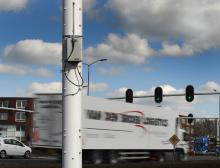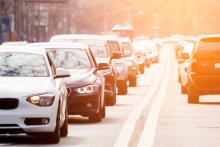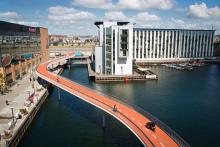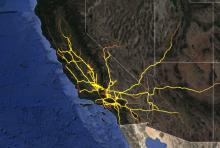
As the ITS World Congress arrives in Copenhagen, Adam Hill finds out how Dynniq has been helping traffic flow – and CO2 reduction - in the Danish capital
Most of the time, ‘breathing easier’ is just an expression which indicates a metaphorical sigh of relief that something has worked out alright. But it can be literally true, too. Respiratory and other potential health problems which stem from pollution in the world’s increasingly urbanised environments have been well publicised and governments are understandably keen to act. Emissions kill, shortening life expectancy and lowering quality of life.
For this reason, like urban authorities all over the world, Copenhagen is aiming to improve air quality for residents. The Danish city, host for the 2018
This big clean-up is an ambitious aim, to which transport is central. As a result, the city authorities have hired a number of partners from the mobility sector to help:
Gridlock waste
If there is one thing that needs sorting out, it is the amount of time that vehicles are stationary with their engines on. Not only is gridlock a terrible waste of people’s lives and an inefficient, costly way to spend time – but it is also just about the most harmful state possible for the environment.
“Traffic jams are the worst thing for CO2 emissions,” says Robbin Blokpoel, lead researcher, Dynniq. With that in mind, the company has set out to change the way that traffic moves through the city of 600,000 people: by making it less stop/start, the hope is that emissions should be reduced.
At the heart of it is a move to make Copenhagen’s traffic lights co-operative. The European Union’s Freilot project has attempted to implement priority for trucks at certain intersections or on specific roads at various times of day to improve the efficiency of urban freight transport. In effect this means that trucks are counted as more important than regular cars - because trucks produce more CO2.
“Every traffic light has a cabinet and from there we control it,” says Rosing-Schow. Dynniq has synchronised controllers, leading local radio to joke that the ‘red wave’ of Copenhagen’s traffic lights is turning into a green wave instead. “GLOSA (green light optimal speed advice) means that, instead of stopping and waiting at lights, you slow down from 40-30km/h, for example, to arrive as the lights are changing,” explains Blokpoel. “The main advantage is: if you stop and then re-accelerate, that’s where a lot of CO2 emissions are caused.”
Low-hanging fruit
To help motorists appreciate the benefits of this approach, there is an app which can be downloaded to smartphone, tablet or on-board device. It displays the current status of lights – red, amber or green – with a bar indicating how long they will stay that way, like an hourglass. “We are targeting trucks initially, starting with the low-hanging fruit,” Blokpoel continues. “You can also give safety messages through the same channel.” Therefore warnings about traffic hold-ups or road closures can be incorporated, giving drivers even more information about their journeys.
Dynniq says that traffic flow has been improved beyond the targets that were originally set and traffic systems have been upgraded to smart systems, including EcoDrive/Compass4D, which was implemented after a successful trial phase. During the pilot, the target had been for heavy transport to go from twelve stops to seven or six. The result was four to five stops, an even greater improvement. This system is now being implemented at over 20 intersections and over 100 buses and other vehicles. The bus priority system has also been upgraded with a connection to a Dynniq-powered server.
Adaptive traffic systems mean that it is possible to prioritise, say, bikes over cars – making it a useful instrument for authorities which are looking to create specific effects in the way that transport moves around an urban area. “That means you can directly put your policy into the system,” says Blokpoel. “It’s very powerful.”
Ideas such as Mobility as a Service (MaaS) are gaining traction, points out Rosing-Schow. “Everyone is looking at intelligent solutions and among these is traffic control, of course,” he says. “There is definitely an increased need. The city of Copenhagen wants to be pioneers in terms of traffic flow. Copenhagen have a huge ITS programme where they have installed a number of intelligent traffic solutions.” Other cities will follow Denmark’s lead, he believes. “The technical solutions are there: it’s a matter of who do you want to prioritise.”
The obvious answers to that question are not necessarily the correct ones in what is a complex mobility environment. “Pedestrians are naturally very important, but in each and every intersection you need to evaluate who needs prioritisation and in which situations,” Rosing-Schow continues.
Future progress
So does Dynniq expect to extend the existing contract? “The only way I can influence it is by doing a good job,” he smiles. “That’s my plan and my expectation: if we do a good job then we develop an even better relationship with Copenhagen.”
The past few years has seen considerable progress when it comes to co-operative intelligent transport systems (C-ITS), with EcoDrive, Compass4D and Freilot all seeking to make an impact. Arching over all these, the C-MobILE programme exists to demonstrate that C-ITS solutions can work well on a large scale in urban scenarios, and that C-ITS technology can be integrated with existing cellular technology.
“We are continuing with the C-MobILE project to open up information for the wider public,” says Blokpoel. “When we started, this was a rarity – but the smartphone revolution over the last few years gives us the opportunity to reach everyone.”
Such projects are not just aimed at car drivers: “Another big target group is cyclists,” he goes on. “They have their phone with them in their pocket and GPS can be with that.” The idea is that making things easier on the roads for cyclists will encourage people to make journeys on two wheels. “That would save more CO2 than just getting cars not to stop. But it’s about reaching as many users as possible.”
As Rosing-Schow concludes: “It’s about improving the experience for citizens.” With everything that is going on, residents should be seeing the benefits of getting to places more easily – and, perhaps even more importantly, will be able to breathe easier.










